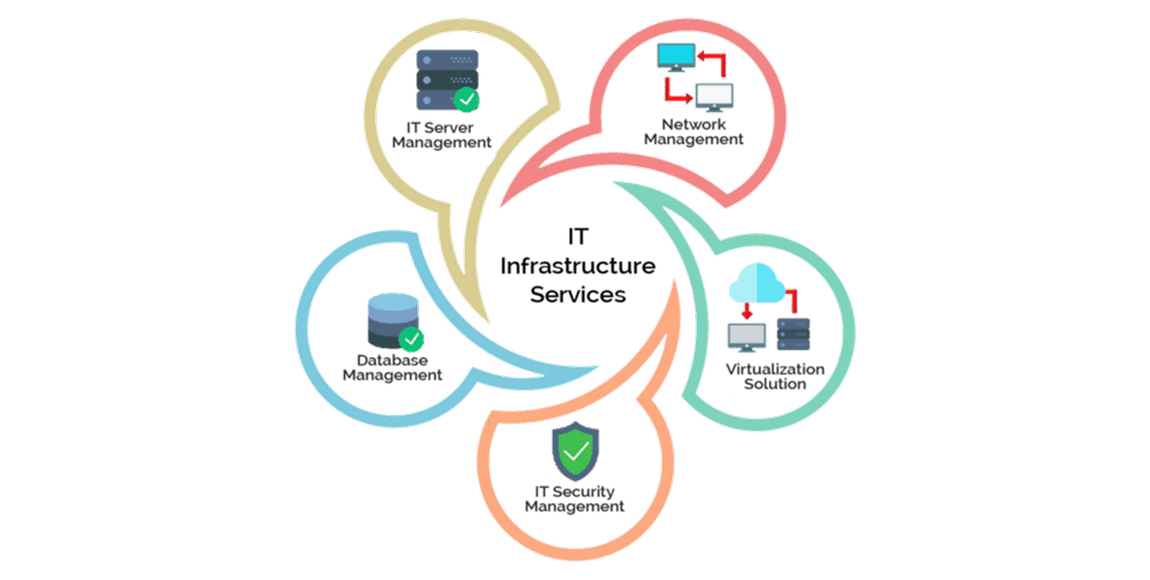
In today’s digital landscape, effective infrastructure management with software is critical for businesses to operate smoothly. To achieve this, organisations turn to IT services and solutions that simplify the complexity of infrastructure management software.
What is Infrastructure Management Software in IT Services and Solutions?
Infrastructure Management Software, in the growing age of IT services and solutions, is a critical component that simplifies the management of an organization’s IT infrastructure, ensuring its efficiency, reliability, and security. The specific software provides a unified platform for supervising various aspects of the IT environment like servers, networks, storage and applications. Infrastructure management software is the need of the hour owing to the rising database of organizations. There is a significant growth in the need for infrastructure management software in the IT services and solutions landscape.
Infrastructure Management Software plays a major role in developing the foundation of any business in IT services and solutions. It empowers organizations to efficiently manage the IT infrastructure that directly ensures reliability, security, and compliance. The software automates tasks like monitoring performance, resource management, and vendor optimization. Infrastructure management software not only enhances operational efficiency but also supports business growth and competitiveness in the ever-evolving IT landscape. In the digital age, the importance of infrastructure management software cannot be overstated, making it an integral part of any IT strategy.
Furthermore, the software assists in tracking and managing IT assets like hardware, software licenses, and warranties. It also plays a vital role in understanding and working around the industry regulations by identifying vulnerabilities and taking necessary actions.
Moreover, it brings automation to the field by making routine tasks and workflows more efficient and reducing the risk of errors. The software helps to decrease manual work and leads to smoother and more reliable IT operations overall. In essence, infrastructure management software is a versatile tool that simplifies the management of IT resources, enhances security, and ensures compliance while optimizing resource use.
In this blog, we’ll delve into the key IT services and solutions that play a crucial role in ensuring seamless infrastructure management.
1. Infrastructure Monitoring Services
Infrastructure monitoring services are the backbone of efficient management. These services provide real-time visibility into the performance of servers, networks, and other infrastructure components. They help in identifying issues proactively, allowing for timely resolutions and minimizing downtime.
2. Network Management Solutions
Networks are the lifelines of modern businesses. Network management solutions ensure that networks are optimally configured, secure, and capable of meeting the organization’s needs. They encompass tasks like monitoring network traffic, managing network devices, and ensuring data security.
3. Server Management Services
Servers are the workhorses of IT infrastructure. Server management services handle server provisioning, maintenance, and optimization. This ensures that servers run efficiently, supporting business-critical applications and services.
4. Storage Solutions
Data storage is a fundamental aspect of infrastructure management. Storage solutions provide scalable and reliable data storage capabilities. They include technologies like Network-Attached Storage (NAS) and Storage Area Networks (SAN) to cater to different storage needs.
5. Virtualization Services
Virtualization services allow organizations to make the most of their hardware resources. They create virtual instances of servers, storage, and networks, enabling efficient resource allocation and reducing hardware costs.
6. Cloud Computing Services
Cloud computing services offer flexibility in infrastructure management. They allow businesses to deploy, scale, and manage resources in the cloud. This flexibility is especially valuable for businesses with fluctuating workloads.
7. Backup and Disaster Recovery Solutions
Data loss and downtime can be detrimental to a business. Backup and disaster recovery solutions ensure that data is regularly backed up and can be quickly restored in case of a disaster or data loss event.
8. Security Services
Security is paramount in infrastructure management. Security services encompass firewall management, intrusion detection, and antivirus solutions to protect the infrastructure from threats and vulnerabilities.
9. Patch Management
Keeping infrastructure components up-to-date is essential for security and performance. Patch management services ensure that servers, software, and devices receive timely updates and patches.
10. Identity and Access Management (IAM) Solutions
IAM solutions control user access to infrastructure resources. They manage user identities, roles, and permissions, enhancing security and compliance.
11. Configuration Management Services
Configuration management services maintain consistency in infrastructure configurations. They help to track changes, ensure compliance with industry standards, and reduce configuration errors.
12. Application Performance Monitoring (APM)
APM services monitor the performance of applications running on the infrastructure. They help to identify bottlenecks, optimize performance, and ensure a seamless user experience.
13. Compliance and Auditing Solutions
Regulatory compliance is a concern for businesses. Compliance and auditing solutions ensure the alignment of infrastructure management with industry regulations and standards.
14. Capacity Planning Services
Capacity planning is essential to accommodate growing infrastructure needs. These services help to predict future resource requirements and offer optimized infrastructure that can handle increased workloads.
15. IT Service Management (ITSM) Tools
ITSM tools facilitate the management of IT services, ensuring that service requests, incidents, and changes are handled efficiently. They contribute to better service delivery and customer satisfaction.
16. Remote Monitoring and Management (RMM)
RMM tools enable IT teams to monitor and manage infrastructure remotely. They provide insights into system health, allowing for proactive troubleshooting.
17. Vendor Management Solutions
Vendor management solutions assist in managing relationships with technology vendors. They help in procurement, contract management, and vendor performance evaluation.
18. Asset Management Services
Asset management services track and manage IT assets, ensuring that hardware and software resources are utilized optimally and within budget.
19. Data Centre Management Solutions
Data centres are central to infrastructure management. Data centre management solutions optimize data centre operations, including power management, cooling, and resource allocation.
20. Reporting and Analytics
Reporting and analytics tools provide insights into infrastructure performance and resource utilization. They help in making data-driven decisions and optimizing infrastructure investments.
In conclusion, IT services and solutions are instrumental in simplifying the complexities of infrastructure management software. By leveraging these services, businesses can ensure the efficient operation of their IT infrastructure, minimize downtime, enhance security, and streamline processes. These services play a pivotal role in enabling organizations to focus on their core operations and adapt to the ever-changing digital landscape with confidence.




